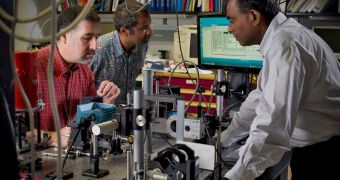Scientists at the NASA Goddard Space Flight Center (GSFC), in Greenbelt, Maryland are currently working on a new generation of spectrometers, which could fit on a silicon wafer. The team wants to improve on existing devices, which are very large and feature numerous moving parts.
The innovative instrument currently under development easily fits in the palm of your hand, unlike the Composite Infrared Spectrometer (CIRS) aboard the NASA Cassini orbiter, which could barely fit in your bathroom or kitchen.
Unlike this reference device, the new one features almost no moving parts, requires only a small space for installation, and consumes significantly lower amounts of electricity. Experts say that power consumption is one of the main reasons why satellites can carry only a small number of instruments.
GSFC experts say that the instrument currently under development is called the Miniaturized Waveguide Fourier Transform Spectrometer (FTS). Like CIRS, it too will be sensitive to the mid-infrared portion of the electromagnetic spectrum.
FTS will be used to measure and analyze the spectra of planets and stars, as well as to identify these objects' chemical makeup and other physical properties. Basically, it will be able to perform all the duties of larger, less efficient spectrometers.
“The Holy Grail is reducing the number of moving parts, which will allow us to build lighter, smaller instruments. The smaller the device, the better. That's where the power of our effort really begins to take off,” explains researcher John Allen, a member of the GSFC FTS team.
However, developing a chip-based spectrometer will also have practical applications outside the field of space exploration. Experts imagine using such devices to scan for dangerous pathogens and chemicals inside shipping containers and trucks, without having to open them.
In addition, FTS spectrometers could be installed on mobile platforms, such as handheld scanners, smartphones and tables. By passing their readings through dedicated apps, every single device could become a part of a larger network, providing spectrometric data from around the world in real time.
“Anywhere you're trying to remotely sense, I think this technology has a multitude of applications,” says Allen. He adds that applications in biotechnology could also put the FTS spectrometer to good use.

 14 DAY TRIAL //
14 DAY TRIAL //